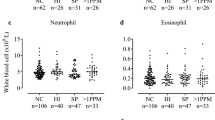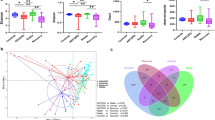Abstract
Purpose
Activation of the interleukin-1β (IL-1β) signaling pathway has been implicated in COPD, but the proportion of COPD subjects whose disease is principally driven by activation of this pathway is poorly understood. In this study, we sought to differentiate an IL-1β-associated sputum signature from other inflammation-associated COPD phenotypes.
Methods
Luminex-multiplex assays were used to study IL-1β-mediated signature proteins within airway epithelium, smooth muscle, and vascular endothelial cell cultures. The IL-1β-mediated signature was tested in a longitudinal study comprising of 35 paired stable-COPD and acute exacerbation (AECOPD) sputum samples. The presence of respiratory pathogens (H. influenzae, M. catarrhalis, S. pneumoniae, and P. aeruginosa) was evaluated by sputum cultures.
Results
Five proteins namely TNF-α, GCSF, IL-6, CD-40L, and MIP-1β were found to be IL-1β-regulated across all donors and cell types. All five of these IL-1β-mediated proteins were significantly increased (p < 0.05) in sputum corresponding to AECOPD events showing at least a twofold increase in IL-1β (IL-1β+ events, 18 of 35 total events), relative to preceding stable-COPD state. Sputum IL-1β levels showed no significant association (p > 0.05, spearman) with known markers of other major COPD inflammation phenotypes. In addition, there was a significant association with bacterial presence in sputum culture with an odds ratio of 9 (95 % CI 1.56, 51.9) in IL-1β+ events versus IL-1β− events.
Conclusion
Our findings provide insights into potential markers of IL-1β-associated AECOPD, and reaffirm association between IL-1β pathway activation and airway bacterial infection in COPD. Taken together, our findings could help identify COPD patient subsets who may benefit from therapies targeting IL-1β pathway.



Similar content being viewed by others
References
Barnes PJ (2000) Chronic obstructive pulmonary disease. N Engl J Med 343(4):269–280. doi:10.1056/NEJM200007273430407
Decramer M, Janssens W, Miravitlles M (2012) Chronic obstructive pulmonary disease. Lancet 379(9823):1341–1351. doi:10.1016/S0140-6736(11)60968-9
Celli BR, Barnes PJ (2007) Exacerbations of chronic obstructive pulmonary disease. Eur Respir J 29(6):1224–1238. doi:10.1183/09031936.00109906
Sethi S, Wrona C, Eschberger K et al (2008) Inflammatory profile of new bacterial strain exacerbations of chronic obstructive pulmonary disease. Am J Respir Crit Care Med 177(5):491–497. doi:10.1164/rccm.200708-1234OC
Bafadhel M, McKenna S, Terry S et al (2011) Acute exacerbations of chronic obstructive pulmonary disease: identification of biologic clusters and their biomarkers. Am J Respir Crit Care Med 184(6):662–671. doi:10.1164/rccm.201104-0597OC
Jones PW, Agusti AG (2006) Outcomes and markers in the assessment of chronic obstructive pulmonary disease. Eur Respir J 27(4):822–832. doi:10.1183/09031936.06.00145104
Botelho FM, Bauer CM, Finch D et al (2011) IL-1alpha/IL-1R1 expression in chronic obstructive pulmonary disease and mechanistic relevance to smoke-induced neutrophilia in mice. PLoS One 6(12):e28457. doi:10.1371/journal.pone.0028457
Sapey E, Ahmad A, Bayley D et al (2009) Imbalances between interleukin-1 and tumor necrosis factor agonists and antagonists in stable COPD. J Clin Immunol 29(4):508–516. doi:10.1007/s10875-009-9286-8
Fu JJ, McDonald VM, Baines KJ et al (2015) Airway IL-1beta and systemic inflammation as predictors of future exacerbation risk in asthma and COPD. Chest 148(3):618–629. doi:10.1378/chest.14-2337
Sethi S, Evans N, Grant BJ et al (2002) New strains of bacteria and exacerbations of chronic obstructive pulmonary disease. N Engl J Med 347(7):465–471. doi:10.1056/NEJMoa012561
Sethi S, Wrona C, Grant BJ et al (2004) Strain-specific immune response to Haemophilus influenzae in chronic obstructive pulmonary disease. Am J Respir Crit Care Med 169(4):448–453. doi:10.1164/rccm.200308-1181OC
Murphy TF, Brauer AL, Schiffmacher AT et al (2004) Persistent colonization by Haemophilus influenzae in chronic obstructive pulmonary disease. Am J Respir Crit Care Med 170(3):266–272. doi:10.1164/rccm.200403-354OC
Sethi S, Murphy TF (2001) Bacterial infection in chronic obstructive pulmonary disease in 2000: a state-of-the-art review. Clin Microbiol Rev 14(2):336–363. doi:10.1128/CMR.14.2.336-363.200117
Russell RE, Culpitt SV, DeMatos C et al (2002) Release and activity of matrix metalloproteinase-9 and tissue inhibitor of metalloproteinase-1 by alveolar macrophages from patients with chronic obstructive pulmonary disease. Am J Respir Cell Mol Biol 26(5):602–609. doi:10.1165/ajrcmb.26.5.4685
Hernandez ML, Mills K, Almond M et al (2014) IL-1 receptor antagonist reduces endotoxin-induced airway inflammation in healthy volunteers. J Allergy Clin Immunol. doi:10.1016/j.jaci.2014.07.039
Ji J, von Scheele I, Bergstrom J et al (2014) Compartment differences of inflammatory activity in chronic obstructive pulmonary disease. Respir Res 15:104. doi:10.1186/s12931-014-0104-3
Perrone LA, Szretter KJ, Katz JM et al (2010) Mice lacking both TNF and IL-1 receptors exhibit reduced lung inflammation and delay in onset of death following infection with a highly virulent H5N1 virus. J Infect Dis 202(8):1161–1170. doi:10.1086/656365
Cukic V (2013) The most common detected bacteria in sputum of patients with the acute exacerbation of COPD. Mater Socio-med 25(4):226–229. doi:10.5455/msm.2013.25.226-229
Confalonieri M, Mainardi E, Della Porta R et al (1998) Inhaled corticosteroids reduce neutrophilic bronchial inflammation in patients with chronic obstructive pulmonary disease. Thorax 53(7):583–585
Brightling CE, McKenna S, Hargadon B et al (2005) Sputum eosinophilia and the short term response to inhaled mometasone in chronic obstructive pulmonary disease. Thorax 60(3):193–198. doi:10.1136/thx.2004.032516
Sohal SS, Soltani A, Reid D et al (2014) A randomized controlled trial of inhaled corticosteroids (ICS) on markers of epithelial-mesenchymal transition (EMT) in large airway samples in COPD: an exploratory proof of concept study. Int J Chronic Obstr 9:533–542. doi:10.2147/Copd.S63911
Woolhouse IS, Bayley DL, Stockley RA (2002) Effect of sputum processing with dithiothreitol on the detection of inflammatory mediators in chronic bronchitis and bronchiectasis. Thorax 57(8):667–671. doi:10.1136/thorax.57.8.667
Author information
Authors and Affiliations
Corresponding author
Ethics declarations
Conflict of interest
The authors have no conflicts to declare with the subject of this study. All authors except Dr. Sanjay Sethi are employees of AstraZeneca/MedImmune.
Rights and permissions
About this article
Cite this article
Damera, G., Pham, TH., Zhang, J. et al. A Sputum Proteomic Signature That Associates with Increased IL-1β Levels and Bacterial Exacerbations of COPD. Lung 194, 363–369 (2016). https://doi.org/10.1007/s00408-016-9877-0
Received:
Accepted:
Published:
Issue Date:
DOI: https://doi.org/10.1007/s00408-016-9877-0




